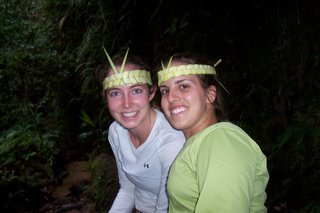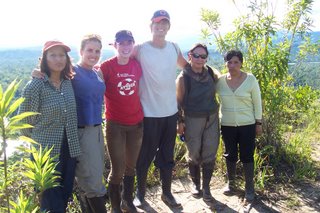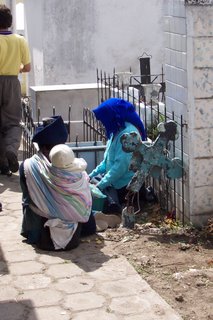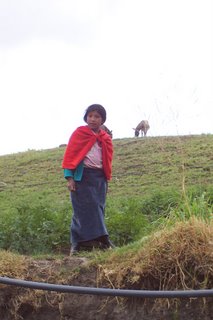Quito fun times
First things first. GO GATORS!!!!!! I watched the entire UF vs. FSU game on Saturday at a sports bar, and I was muy orgullosa of the Florida Gators. I screamed and was the ugly American in the bar, but oh well, it was really funny. People tend to not have any interest whatsoever in American football here, and they really didn’t know why I was so engrossed in the game. They were watching Ronaldinho on the other T.V. (Barcelona vs. Villa Real), which was also an amazing game. That man scored some beautiful goals. Anyway, it was a day full of sports, which usually isn’t my cup of tea, but it was a much needed taste of Americana I think.
Thanksgiving was a fiesta! Emily and I cooked up a storm. We made turkey, sweet tea, peas, garlic mashed potatoes, sautéed mushrooms, BBQ beans, potato salad, cranberry sauce (well, from a can), spiced apples, seven layer bars, chocolate pudding, and the crowning achievement….PUMPKIN PIE from a real pumpkin. We rock. We tried finding the ingredients for other things, but it was a quest for the holy grail, so we were content with what we could actually find. The family I’m staying with had never tried most of the food we prepared, and it was really fun sharing the holiday with them. We even had little Thanksgiving placemats and pumpkin colored candles. I was sad to be away from my family, and especially my sister, but it was good fun to bring the tradition to Ecuador and to prove ourselves as qualified cooks. The family told me that, in light of such tasty culinary achievements, it appears as thought I am now prepared to marry. I laughed because I knew there was a shred of sincerity in their comment. (In the past here, men had to prove their hunting skills and women, their culinary skills, in order to be deemed ready for marriage). I’m glad the times have changed! I brought some of the leftovers to school the next day, and the teachers and students also really liked trying pumpkin pie. It was really funny fielding their questions about the food because it’s typical food to me, but they looked and poked at it like it was an alien creation.
Sunday was the second round of the presidential elections. As I noted in a prior blog, the election appeared to be HIGHLY corrupt, but I’m really happy that Rafael Correa won. The election was between two highly controversial men, Alvaro Noboa and Rafael Correa. Noboa is the wealthiest man in Ecuador and one of the wealthiest men in the world. He owns about 130 businesses here and runs the great majority of the country’s banana plantations. He has run twice before in the past, and has lost, so many speculated that he would bribe and buy his way into the presidency this time, as to not risk losing face for the third and final time. He has claimed that he has been sent by God to run this country in public speeches, and while the Quiteños laughed, many of the people from the pueblos believed him. He made some really outlandish promises, like his initiative to build 300,000 homes in a year. Many pointed out that this would require an almost impossible construction rate as well as land that Ecuador simply doesn’t have, especially in the city. I recently watched a documentary that a Swedish woman made about Noboa’s mistreatment of his banana plantation workers. I swear I watched the entire thing with my mouth agape, and I vowed to never buy bananas again (but then I thought about how much I love bananas). I saw the plantations and the decrepit living conditions of his workers. They receive about $20 a week, if that, live eight people to a room (two to a single bed), use cardboard for their mattress, store water in banana plastic bags with toxic chemicals, use bathrooms with fecal matter spilling over onto the floor, and are covered with pesticides that fall from aerial sprays. Granted this documentary showed only one person’s point of view, but what she captured on film was undeniably grotesque. When the workers rioted and striked due to their horrible living conditions and pay, Noboa paid off assassins in Guayaquil to start shooting at the plantation. She got this all on tape. The police stood idly by as killers invaded the plantation. What really struck me about this story was not only Noboa’s explotation of the people, but that the workers don’t have any other options for work. They subject themselves to these conditions, these chemicals, and this mistreatment because they view this as their only option for work.
The sad part is that Noboa had a compelling and effective way of garnering the votes of the poorer people of this country, which far outnumber the wealthy. And in a country where everyone has to vote, wealth and education don’t win, numbers do. Thankfully the numbers were in Correa’s favor. By appealing to his divine connection to the Almighty and by literally handing out food and clothing, he won the support of many. When I was in the jungle last week, for example, I noticed that the only shirts that the people at the camp wore were political advertisements in support of presidential candidates and others political offices. Why wouldn’t a person vote for a candidate that gives them food, clothing, and the promise of shelter?
The Ecuadorian economy is not the strongest, and many people fear the influx of foreign businesses and free trade. I’ve seen “No T.L.C” (free trade) grafitti everywhere because the majority of the people prefer Ecuadorian, not foreign, products on the market. They already have problems with Asian products flooding the markets because producers of similar products here are going out of business because they simply can’t produce the same product at such a low cost. Noboa wanted to open the borders completely, which would definitely have it’s benefits, but many Ecuadorians would lose immensely and their economy would really have to reshape itself. A temporary shock for a permanent gain? Who knows? The same was said about dollarization here, and the people are still suffering.
I’ve talked more about Noboa (thoroughly criticized really) because I’ve read and had conversations mostly about the threat of his coming to power here. He was the more sensational and controversial figure. Rafael Correa was the favored candidate in Ecuador more for his not being Noboa than for his merits actually. He is an economist by profession, and he’s come into the political sphere kind of by surprise. While he doesn’t have any glaring downfalls, the people are skeptical because he is like many other presidential candidates of the past who have won and have robbed the country blind. Correa is said to be on good terms with Hugo Chavez, the Venezuelan president, and many Americans here fear this friendship, which also extends to Fidel Castro. Correa made quite a few lofty promises in his platform, so time will tell.
During this election I have really come to think about the American electoral system.
For instance, voting here is mandatory, and you don’t vote, you’re fined (both times). Is it better to mandate obligatory voting, or does the American system of voluntary voting engender better results? Is one form more “democratic” than the other? Is it better to only have the informed and opinionated at the voting booths? I really don’t know.
Good news! These upcoming days (leading up until the 6th of December) are the “Fiestas de Quito” for the founding of the city. There is so much going on that I can’t even keep track of it all, let alone see it all. Tomorrow I am going to my first bull fight, and I am really looking forward to it. A woman “torera” will even be fighting! That’s exciting because it is extremely rare to see a woman in this arena. Shakira is also coming this weekend, and I am going to see her with my new roommate. Que suerte to see Shakira in South America! I hope it’s all in Spanish…
I hope all of your Thanksgivings were tasty and full of fun and family. Please let me know how you are doing if you get a few free moments. Take care.
(Apologies for not having pictures. I have tons, but for some reason the blog won't upload them. Maybe next time:)





 (This is basically a crucified pig that is surrounded by skinned guinea pigs that all have packs of cigarettes and alcohol tied to them)
(This is basically a crucified pig that is surrounded by skinned guinea pigs that all have packs of cigarettes and alcohol tied to them)



